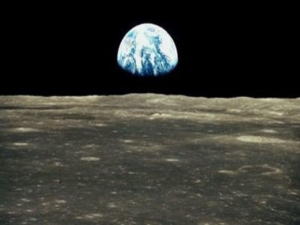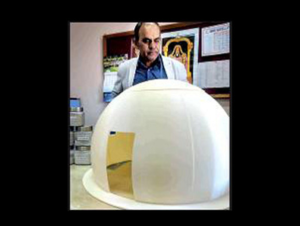 This year, the Indian Space Research Organisation (ISRO) will launch its second trip to the moon. If all goes well, the 3,290 kg Chandrayaan-2 spacecraft will be orbiting over the far side of the moon at some point this summer, completely out of contact with controllers back home on Earth. It will then begin a difficult mission – releasing a lander, containing a rover, which should have a soft landing near the moon’s south pole right after the lunar sunrise. Then, the rover will be sent out into territory that’s never been explored before – far from the lunar equator, where there is less sunlight.
This year, the Indian Space Research Organisation (ISRO) will launch its second trip to the moon. If all goes well, the 3,290 kg Chandrayaan-2 spacecraft will be orbiting over the far side of the moon at some point this summer, completely out of contact with controllers back home on Earth. It will then begin a difficult mission – releasing a lander, containing a rover, which should have a soft landing near the moon’s south pole right after the lunar sunrise. Then, the rover will be sent out into territory that’s never been explored before – far from the lunar equator, where there is less sunlight.
Wu Ji, Director of the National Space Science Center in Beijing, said, “It is a difficult and complicated mission.”
According to Kailasavadivoo Sivan, the ISRO Chairman in Bengalaru, if the Chandrayaan-2 is successful, it will not only prepare the way for more ambitious Indian missions to space, but also demonstrate without a doubt that the country has the capability and technology “to soft land on other heavenly bodies.”
But the difficult mission isn’t just about proving that India can handle missions like landing on Mars and sending a probe to Venus – the orbiter is picking up where the Chandrayaan-1 left off when it discovered water molecules on the moon nearly ten years ago.
“It was kind of a kooky science to think that you’d find water,” James Greenwood, a cosmochemist at Wesleyan University, said regarding previous thoughts about water on the moon before the 2009 mission. “Now, we’re arguing about how much water, and not whether it has water or not.”
Cameras and a spectrometer aboard the Chandrayaan-2 orbiter could help answer this question. In addition, several instruments aboard both the lander and the 25 kg rover will be busy collecting important data about the thin envelope of plasma on the moon. A seismometer will record moonquakes, two spectrometers will probe the elemental composition of the lunar surface, and the orbiter’s water mapper will hopefully capture some information on the moon’s water circulation.

A model of Chandrayaan-2’s rover undergoing tests to prepare for operating in the moon’s anemic gravity. [Image: ISRO]
Figuring out how to build successful habitats in space is a focus for many organizations right now, and several are using 3D printing technology to do so. ISRO is doing the same thing, and is developing 3D printable igloo-like structuress that will be used as lunar habitats.
Mylswamy Annadurai, Director of the ISRO Satellite Centre, said, “There has been a rebirth of lunar exploration across the globe, and India can’t be left behind.”
The igloos, which will eventually be built out of lunar soil and other materials on the moon by robots and 3D printers, will be used as future outposts for astronauts on the moon.
“We are seriously planning to use the Moon as an outpost – like missions in Antarctica,” explained Annadurai. “In the long run, the space station is likely to be scrapped. Many countries, including the US, are considering building more permanent structures on the Moon and working out of there. When it happens, we want India to have contributed.”
Work on this project began in 2011, and Annadurai said ISRO has figured out how to create a material that approximates the properties of lunar soil, actually matching 99.6% with the lunar samples brought from back by NASA’s Apollo missions, and currently has about 60 metric tons of it, at the lower price of Rs 10 lakh, that are ready to use.
- [Images: The Times of India]
I. Venugopal, the Senior Scientist and Project Lead, applied for a global patent for ISRO’s process of manufacturing the material.
“It may sound crazy today,” said Venugopal. “But you’ll see that one day men will be working out of there, and the goal is to launch interplanetary satellites from the Moon.”
The soil simulant is currently being used to test the lander for the Chandrayaan-2 mission. Meanwhile, ISRO is making progress with a working 3D printed model of the igloo, which is located in its lunar terrain test facility. A total of five designs have been drawn up for the habitats, and scientists hope that their work will help with future plans of creating lunar outposts.
Annadurai said, “To keep them safe and help them work from there, we need smart materials, which is what we are focusing on building.”
Discuss this and other 3D printing topics at 3DPrintBoard.com or share your thoughts below.
[Source: The Times of India]
Subscribe to Our Email Newsletter
Stay up-to-date on all the latest news from the 3D printing industry and receive information and offers from third party vendors.
You May Also Like
Precision at the Microscale: UK Researchers Advance Medical Devices with BMF’s 3D Printing Tech
University of Nottingham researchers are using Boston Micro Fabrication‘s (BMF) 3D printing technology to develop medical devices that improve compatibility with human tissue. Funded by a UK grant, this project...
3D Printing Webinar and Event Roundup: April 21, 2024
It’s another busy week of webinars and events, starting with Hannover Messe in Germany and continuing with Metalcasting Congress, Chinaplas, TechBlick’s Innovation Festival, and more. Stratasys continues its advanced training...
3D Printing Webinar and Event Roundup: March 17, 2024
It’s another busy week of webinars and events, including SALMED 2024 and AM Forum in Berlin. Stratasys continues its in-person training and is offering two webinars, ASTM is holding a...
3D Printed Micro Antenna is 15% Smaller and 6X Lighter
Horizon Microtechnologies has achieved success in creating a high-frequency D-Band horn antenna through micro 3D printing. However, this achievement did not rely solely on 3D printing; it involved a combination...
































